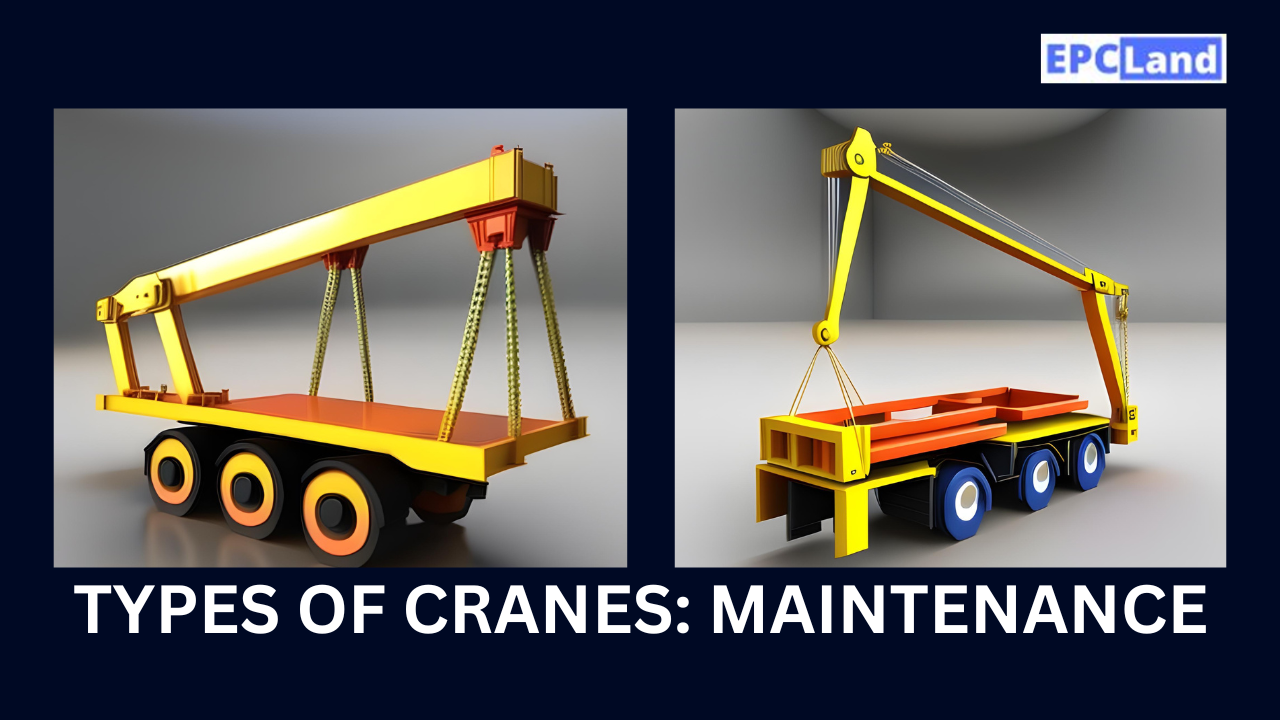Introduction
Cranes stand as indispensable giants in a multitude of industries, serving as the backbone of construction, manufacturing, shipping, and more. These towering machines play a pivotal role in moving heavy loads with precision and efficiency, ultimately shaping the modern infrastructure we rely upon. As the heartbeat of development projects, understanding the diverse types of cranes available becomes paramount. This knowledge not only ensures the safety of workers and equipment but also maximizes operational effectiveness.
Table of Contents
Don’t miss course on Anatomy of Cranes (35 Types): Maintenace Equipment
Enrollment Link
Significance of Cranes
Cranes have been pivotal throughout history, evolving from rudimentary designs to intricate, high-tech marvels. Their significance transcends industries, as they contribute to the construction of skyscrapers that redefine urban landscapes, aid in assembling large-scale manufacturing equipment, and facilitate the loading and unloading of cargo containers at bustling ports. The world as we know it would not be possible without these mechanical giants that gracefully lift, move, and position heavy objects with precision.
Importance of Understanding Crane Types
In a world where diverse projects require specific tools, having a comprehensive understanding of the various types of cranes available is not a luxury, but a necessity. Different projects call for different crane types, each equipped with unique features and capabilities. Such knowledge allows professionals to select the most suitable crane for a particular task, ensuring optimal efficiency and minimizing risks. By delving into the intricacies of crane types, workers and decision-makers alike can safeguard their projects and personnel.
Stay tuned as we embark on a journey to explore the different types of cranes in detail. This course promises to equip you with the knowledge needed to make informed choices, promoting safety, efficiency, and excellence in the dynamic world of crane operations.
Understanding Cranes and Their Applications
Defining Cranes and Their Historical Significance
Cranes, in their essence, are mechanical devices designed to lift and move heavy objects with relative ease. The concept of cranes dates back to ancient civilizations, where human and animal power were harnessed to create primitive lifting systems. Over time, technological advancements led to the development of more sophisticated crane designs, utilizing pulleys, gears, and hydraulics.
Role of Cranes Across Industries
The versatility of cranes has led to their integration into a wide range of industries. Whether it’s constructing skyscrapers that touch the sky, assembling intricate machinery in manufacturing plants, or aiding in the logistical challenges of ports and shipping yards, cranes are a driving force behind modern development. Their ability to handle immense weights and maneuver with precision makes them indispensable tools in the hands of skilled operators.
Cranes in Modern Infrastructure Development
In the modern world, cranes are synonymous with progress and development. They are the silent companions of architects, engineers, and laborers, supporting them in realizing their grand visions. The skylines of major cities are dotted with tower cranes, symbols of ongoing construction and urban growth. The development of new infrastructure, from roads and bridges to energy installations, is accelerated by the power of cranes. Without their lifting prowess, the pace of innovation and expansion would significantly slow down.
Stay engaged as we dive deeper into the intricate world of crane types, exploring the specifics of each variation and understanding how they contribute to the diverse tapestry of industries they serve.
Don’t miss course on Anatomy of Cranes (35 Types): Maintenace Equipment
Enrollment Link
Types of Cranes
A. Mobile Cranes
Mobile cranes are versatile lifting machines that are mounted on wheeled chassis, allowing them to be easily transported to various job sites. These cranes are known for their flexibility and agility, making them suitable for a wide range of applications.
Subtypes of Mobile Cranes
- All-Terrain Cranes: These cranes combine the features of both rough terrain and truck-mounted cranes. They can navigate various terrains while still maintaining road-worthiness for highway travel.
- Rough Terrain Cranes: Engineered for off-road use, these cranes are ideal for rugged environments. They possess robust tires and exceptional stability, enabling them to function effectively on uneven surfaces.
- Truck-Mounted Cranes: Mounted on trucks, these cranes are highly mobile and offer the convenience of self-propulsion. They are often used for smaller lifting tasks and can quickly be dispatched to different locations.
- Crawler Cranes: These cranes move on a set of tracks instead of wheels, providing enhanced stability and weight distribution. Crawler cranes excel in heavy lifting tasks and are commonly found on large construction sites.
Applications of Mobile Cranes
Mobile cranes find applications in various scenarios, including:
- Construction projects, where they lift and place heavy building materials.
- Maintenance tasks, such as lifting equipment for repairs or installations.
- Emergency response situations, aiding in disaster relief efforts.
- Setting up temporary structures at events or industrial sites.
Stay tuned as we explore more crane types, unraveling their unique features, advantages, and real-world applications in different industries.
B. Tower Cranes
Tower cranes are iconic symbols of large-scale construction projects, particularly in urban areas. These cranes are characterized by their towering height and ability to lift heavy loads to significant heights.
Components of Tower Cranes
- Mast: The vertical component of the tower crane, which provides its height. Masts are made of sections that are assembled as the crane grows taller.
- Slewing Unit: The part of the crane that allows it to rotate horizontally. This rotation enables the crane to cover a wide area without needing to reposition its base.
- Jib: The horizontal arm of the crane that extends outward from the mast. The load is attached to the jib’s hook, allowing it to be lifted and moved.
- Counterweights: These weights help balance the crane and prevent it from toppling over due to the heavy loads being lifted.
Tower Crane Erection and Dismantling
Tower cranes are erected in sections as the building they’re assisting in constructing grows taller. Once the construction project is complete, the crane is dismantled in the reverse order, with sections of the mast being removed as the crane’s height decreases.
Role of Tower Cranes in Construction
Tower cranes play a vital role in high-rise construction projects. Their impressive height and lifting capabilities make them essential for lifting heavy building materials, such as steel beams and concrete blocks, to upper levels. They enhance construction efficiency by reducing the need for manual labor and improving the overall project timeline.
Stay engaged as we continue to delve into various crane types, understanding their unique attributes and the pivotal roles they play across different industries and applications.
Don’t miss course on Anatomy of Cranes (35 Types): Maintenace Equipment
Enrollment Link
C. Overhead Cranes
Overhead cranes, also known as bridge cranes, are designed to lift and transport heavy loads within a fixed area. They are commonly used in industrial settings and manufacturing facilities.
Components of Overhead Cranes
- Bridge: The horizontal beam that runs along the length of the crane’s runway. The bridge carries the hoist and trolley, allowing them to move along the length of the crane.
- Hoist: The lifting component of the crane that raises and lowers the load. It’s equipped with a hook or other lifting device.
- Trolley: The mechanism that moves the hoist horizontally along the bridge, allowing for precise positioning of the load.
Single Girder vs. Double Girder Overhead Cranes
- Single Girder Overhead Cranes: These cranes have one bridge beam, making them lighter and more economical. They are suitable for lighter loads and lower-duty applications.
- Double Girder Overhead Cranes: These cranes feature two bridge beams, offering increased stability and capacity. They are commonly used for heavy-duty applications and lifting larger loads.
Applications of Overhead Cranes
Overhead cranes are utilized in various industrial contexts, including:
- Manufacturing processes, such as moving materials along an assembly line.
- Warehousing, for loading and unloading heavy items from storage racks.
- Steel and metal fabrication, where precision lifting is crucial.
- Maintenance tasks, like lifting machinery for repairs.
As we progress through our exploration of crane types, we’ll continue to uncover the distinct attributes and functions of each crane variety, providing a comprehensive understanding of their roles in different sectors.
D. Gantry Cranes
Gantry cranes are versatile lifting solutions commonly used in ports, shipping yards, and manufacturing facilities. They are known for their ability to handle heavy loads over large distances.
Understanding Gantry Cranes and Their Variations
- Rubber-Tired Gantry (RTG) Cranes: These gantry cranes are equipped with rubber tires, allowing them to move along designated paths within container yards. RTG cranes are used for stacking and moving shipping containers.
- Rail-Mounted Gantry (RMG) Cranes: RMG cranes run on rails, offering stability and precision. They are frequently used in intermodal yards to lift and move containers from trains to trucks.
Applications of Gantry Cranes
Gantry cranes have a wide range of applications, including:
- Handling shipping containers in ports and container terminals.
- Loading and unloading cargo from ships and trains.
- Moving heavy materials in construction and manufacturing settings.
- Assisting in logistics and supply chain operations.
Stay engaged as we continue to explore the different types of cranes, uncovering their unique characteristics and how they contribute to the efficient movement of goods and materials in various industries.
E. Jib Cranes
Jib cranes are compact lifting solutions that are designed for smaller workspaces and localized lifting tasks. They consist of a vertical mast or pillar and a horizontal jib arm.
Understanding Jib Cranes and Their Features
- Wall-Mounted Jib Cranes: These cranes are mounted on a wall or vertical surface. They are ideal for areas with limited floor space and are often used for precision lifting tasks.
- Freestanding Jib Cranes: Freestanding jib cranes are independent structures that are not attached to walls. They provide a higher degree of mobility and can be placed where needed.
Applications of Jib Cranes
Jib cranes find applications in various industries and tasks, such as:
- Lifting and moving materials in workshops and manufacturing facilities.
- Assisting in machine loading and unloading.
- Precise placement of heavy components during assembly.
- Supporting maintenance and repair tasks in confined spaces.
As our exploration of crane types nears its conclusion, we have gained a comprehensive understanding of the diverse cranes that contribute to different sectors’ efficiency and productivity. Stay tuned for the next sections, where we’ll delve into the factors to consider when selecting a crane, the importance of crane operation safety, and the advances in crane technology that are shaping the future of these indispensable machines.
Don’t miss course on Anatomy of Cranes (35 Types): Maintenace Equipment
Enrollment Link
Selection Criteria for Cranes
Factors Influencing Crane Selection
When choosing a crane for a specific task, several critical factors come into play:
- Load Capacity: The maximum weight the crane can safely lift is a primary consideration. Selecting a crane with an appropriate load capacity is essential for both safety and efficiency.
- Reach and Height: The crane’s reach and lifting height should match the requirements of the task. A crane with insufficient reach may lead to logistical challenges, while excessive reach might compromise stability.
- Environmental Conditions: The work environment, including factors like weather, temperature, and terrain, influences the choice of crane type. Certain cranes are better suited for specific conditions, such as rough terrains or confined spaces.
- Mobility and Maneuverability: Depending on the project’s nature, a crane’s mobility and ability to move within the work area can significantly impact its effectiveness.
- Budget and Cost Considerations: Procuring, operating, and maintaining a crane involves costs. Balancing functionality with budgetary constraints is crucial.
- Regulatory and Safety Requirements: Compliance with safety regulations and standards is non-negotiable. Choosing a crane that meets these requirements is imperative to ensure the safety of personnel and equipment.
Case Studies in Crane Selection
Exploring real-world case studies showcases the importance of proper crane selection. Examples might include scenarios where using the wrong crane type resulted in delays, safety hazards, or inefficiencies. Conversely, successful cases highlight how a well-chosen crane contributed to smooth operations and project completion.
Stay engaged as we delve into the intricacies of crane selection, understanding the art of matching crane capabilities with project demands to achieve optimal outcomes.
Crane Operation and Safety
Basics of Crane Operation
- Controls and Operation: Crane operators utilize control systems to move the crane’s various components. Familiarity with control interfaces and their functions is essential for safe and precise operation.
- Load Handling Techniques: Proper techniques for attaching, lifting, moving, and placing loads are crucial to prevent accidents and damage to the load or equipment.
- Stability and Balance: Understanding a crane’s load chart and ensuring that loads are within safe operating limits is essential for maintaining crane stability and preventing tip-overs.
Pre-Operational Checks and Maintenance
- Pre-Operational Inspection: Conducting thorough pre-operational checks ensures that the crane is in proper working condition. This includes examining components like ropes, hooks, brakes, and safety devices.
- Routine Maintenance: Regular maintenance routines, including lubrication, adjustments, and inspections, extend the crane’s lifespan and reduce the likelihood of breakdowns during critical tasks.
Emphasizing Crane Safety
- Safety Protocols: Implementing strict safety protocols, such as using taglines, following proper signaling, and maintaining safe working distances, reduces the risk of accidents.
- Training and Certification: Proper training and certification of crane operators are vital for safe operations. Operators must understand crane mechanics, load capacities, and safety procedures.
- Emergency Procedures: Crane operators should be well-versed in emergency shutdown procedures and be prepared to respond effectively in the event of power loss, mechanical failures, or other emergencies.
Stay engaged as we delve deeper into the world of crane operation and safety, understanding the importance of proper training and adherence to safety guidelines to ensure smooth operations and protect the well-being of personnel and equipment.
Advances in Crane Technology
Integration of Technology in Cranes
- Remote Control: Modern cranes often feature remote control systems that allow operators to control the crane from a safe distance, enhancing operator safety and precision.
- Automation: Automation technology enables cranes to perform predefined tasks with minimal human intervention, improving efficiency and reducing the risk of errors.
- Sensors and Monitoring: Sensors integrated into cranes provide real-time data on factors like load weight, crane stability, and environmental conditions, enhancing safety and decision-making.
Benefits of Digitalization in Crane Management
- Data Analytics: The collection and analysis of crane operation data can lead to insights that optimize operational efficiency, reduce downtime, and enhance maintenance planning.
- Predictive Maintenance: By monitoring key components, predictive maintenance algorithms can predict potential failures, allowing for proactive maintenance and reducing unplanned downtime.
- Efficient Resource Allocation: Digital tools can help allocate resources effectively, ensuring that cranes are assigned to tasks based on their availability and capabilities.
Future Trends in Crane Technology
- IoT Integration: The Internet of Things (IoT) will play a significant role in crane technology, enabling interconnected devices that communicate and collaborate seamlessly.
- AI and Machine Learning: These technologies can enhance crane safety by analyzing complex data in real-time and assisting operators in making informed decisions.
- Hybrid Power Systems: The adoption of hybrid power systems in cranes, combining traditional power sources with renewable energy, can lead to reduced emissions and improved sustainability.
Stay engaged as we explore the cutting-edge advancements in crane technology, understanding how these innovations are revolutionizing the way cranes are operated, maintained, and integrated into various industries.
Don’t miss course on Anatomy of Cranes (35 Types): Maintenace Equipment
Enrollment Link
Training and Certification
Importance of Proper Training
- Operator Competence: Proper training ensures that crane operators are skilled in safe and efficient crane operation, reducing the risk of accidents and equipment damage.
- Regulatory Compliance: Many jurisdictions require crane operators to be certified and trained according to specific standards and regulations.
- Enhanced Efficiency: Well-trained operators can maneuver cranes with precision, maximizing productivity and minimizing downtime.
Overview of Crane Operator Certification Programs
- Curriculum: Certification programs cover crane operation techniques, safety procedures, load calculations, and maintenance basics.
- Hands-On Training: Practical experience is a critical component, allowing operators to apply theoretical knowledge in real-world scenarios.
- Examinations: Certification often involves written and practical examinations to assess an operator’s knowledge and skills.
Impact on Operational Efficiency
- Safety: Trained operators are more adept at recognizing and avoiding potential hazards, promoting a safer working environment.
- Equipment Longevity: Proper operation and maintenance techniques learned during training contribute to the extended lifespan of cranes.
- Operational Excellence: Trained operators can complete tasks more efficiently, reducing project timelines and associated costs.
As we approach the conclusion of our exploration, it’s evident that proper training and certification play a pivotal role in ensuring safe and efficient crane operations. Investing in well-trained personnel leads to improved productivity, safety, and overall project success.
Conclusion
Cranes, the giants of modern industries, stand as testament to human ingenuity and progress. From humble beginnings to the sophisticated machines we see today, cranes have played a pivotal role in shaping our world. Understanding the intricacies of different crane types has proven to be essential for safety, efficiency, and innovation across various sectors.
Through this comprehensive course, we have embarked on a journey to explore the diverse types of cranes that contribute to construction, manufacturing, shipping, and more. We’ve delved into their applications, components, and operational considerations. We’ve uncovered the art of selecting the right crane for the job and emphasized the significance of proper training and safety protocols.
As we move forward, remember that the knowledge gained here serves as a foundation for making informed decisions, promoting safety, and driving excellence in crane operations. The world continues to evolve, and so do the technologies and techniques related to cranes. By staying attuned to industry advancements and fostering a culture of continuous learning, we can contribute to a future where cranes continue to play a vital role in shaping our ever-changing landscape.
Don’t miss course on Anatomy of Cranes (35 Types): Maintenace Equipment
Enrollment Link
FAQs
Here are five frequently asked questions (FAQs) that are commonly associated with the topic of cranes:
- What are the main industries that rely on cranes?Cranes are essential in a variety of industries, including construction, manufacturing, shipping and logistics, mining, oil and gas, and port operations. They are used for tasks ranging from lifting heavy building materials to moving cargo containers and assembling large machinery.
- What factors should be considered when selecting the right crane for a specific task?Several factors play a role in selecting the appropriate crane, including the required load capacity, lifting height, reach, work environment (indoor or outdoor), mobility requirements, budget constraints, and adherence to safety regulations.
- Why is proper crane operator training important?Proper training ensures that crane operators have the necessary skills and knowledge to operate cranes safely and efficiently. Trained operators can prevent accidents, accurately calculate load capacities, and handle unexpected situations, contributing to a safer work environment and improved operational outcomes.
- What are the advantages of integrating technology in crane operations?Integrating technology in crane operations offers benefits such as improved precision, enhanced safety through remote control and automation, real-time monitoring of crane conditions, data-driven decision-making for maintenance planning, and increased operational efficiency.
- How is crane safety maintained during operations?Crane safety is upheld through rigorous adherence to safety protocols. This includes pre-operational checks, proper load handling techniques, maintaining crane stability, following safety guidelines for signaling and communication, and having well-defined emergency procedures. Additionally, operators should be well-trained and certified to ensure safe crane operations.
Recommended courses (Published on EPCLand)
- Basics of Piping Engineering
- Piping Layout Engineering
- Piping Material Engineering
- Piping Stress Analysis
- Complete Course on Piping Engineering
- Material Requisitions
- Piping Material Specifications
- Valve Material Specifications
Don’t miss the published articles on following:
Related Video
Attempt Quiz
Question 1:
Which type of crane is known for its vertical lifting capability and used in construction?
Explanation: A Tower Crane is known for its tall structure and vertical lifting capability, often used in construction for lifting heavy materials and equipment to great heights.
Question 2:
Which type of crane is commonly used in shipyards to lift heavy loads onto ships?
Explanation: A Floating Crane is commonly used in shipyards to lift heavy loads onto ships. It is positioned on a barge or floating platform for versatile lifting operations.
Question 3:
Which type of crane features a horizontal arm (jib) that can rotate around a pivot?
Explanation: A Jib Crane features a horizontal arm (jib) that can rotate around a pivot, allowing for flexible lifting and positioning of loads.
Question 4:
Which type of crane is mounted on a vehicle and can be easily transported to different locations?
Explanation: A Mobile Crane is mounted on a vehicle and equipped with wheels or tracks, allowing it to be transported to different locations for various lifting tasks.
Question 5:
Which type of crane is often used for indoor lifting operations within factories and warehouses?
Explanation: An Overhead Crane is often used for indoor lifting operations within factories and warehouses. It is suspended from the ceiling and allows for efficient material handling.



